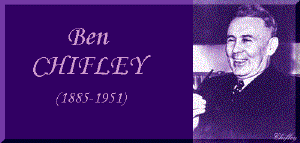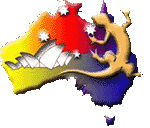|
          |
Prime Minister Curtin appointed him treasurer in October 1941, a portfolio he retained on becoming prime minister in 1945. As Minister for Post-War Reconstruction, he and Curtin laid the foundations for future social and economic policy. The immediate post-war period saw expansion of social services, the creation of a national airline (TAA), the Holden car and the Snowy Mountains Scheme. Australia's present multicultural society owes its beginnings to the Chifley government's visionary immigration policy. Chifley was also committed to full employment but industrial unrest caused his government serious problems. Chifley lost control of the government in 1949 on the issues of bank nationalisation and continued rationing . He stayed on as Opposition leader, and died in June 1951. "One of the most lovable men ever to have inhabited Parliament House," said Harold Holt of his political opponent Ben Chifley. An unpretentious, self-educated man who spoke with a working class accent, Chifley was dedicated to social reform and saw the Labor movement as "bringing something better to the people, better standards of living, greater happiness..." Ben Chifley was born in Bathurst on September 22, 1885, of working class parents. He had only rudimentary education but developed early his life-long passion for reading. On leaving school he worked in a shop, then a tannery before joining the railways and becoming a first class engine driver at age 24. He married Elizabeth McKenzie in 1914. He twice stood unsuccessfully for pre-selection to State Parliament, won the Federal seat of Macquarie in 1928, only to lose it again in 1931, and also in 1934 and 1937. Between contesting elections he set out to rebuild Labor's powerbase in New South Wales and was prominent in Bathurst affairs. By the time of his election in 1940 he had endeared himself to the Labor movement by his integrity, his commitment to the ideals of the Party and his unassuming behaviour. When Curtin became prime minister in October 1941 he appointed Chifley as treasurer. Labor introduced uniform taxation (making the Commonwealth government responsible for collecting tax whereas previously both the federal government and the states collected taxes) and P.A.Y.E. (Pay As You Earn). Chifley was a first class administrator ensuring the smooth management of parliamentary business. During Curtin's final illness Chifley's performance as acting prime minister made him the natural choice as Curtin's successor. World War II ended one month after Chifley took office. Curtin and Chifley had already begun planning post-war reconstruction and a fairer distribution of wealth. Chifley was determined to retain uniform taxation laws and to keep a tight rein on the economy to prevent inflation. Price and rent controls continued, as well as rationing of essential products-some food items and petrol, which in those days was all imported. Oil had not been discovered in Australia and commercial production of Bass Strait oil did not begin until 1969. In Chifley's view Australia needed to grow-"populate or perish". Arthur Calwell was given the important Immigration portfolio. Assisted passages were offered mainly to British migrants, but the offer also included displaced persons from eastern Europe, refugees and northern Europeans. The scheme was later extended to cover southern Europeans. This was the first stage in dismantling the White Australia policy, a basic tenet of federation. The wartime economy had pinpointed the need for an Australian-based motor vehicle industry (until that time either the whole car or the chassis was imported). Chifley and Lawrence Hartnett, the managing-director of the American-owned General Motors-Holden Company in Adelaide were enthusiastic, but the parent GM company would not supply any finance. Chifley arranged for the Commonwealth bank and the Bank of Adelaide to put up 3 million to finance the project. The first Holden rolled off the production line on November 29, 1948. Probably the most imaginative engineering project in Australia's history, the Snowy Mountains Hydro-Electric Scheme, was begun in 1949. About 6000 workers were needed for the project, many of them migrants living in construction camps and new towns. The opposition boycotted the inauguration but later claimed credit. In foreign affairs Chifley was anti-colonial, favoured British withdrawal from India and sided with the Indonesian nationalists, supporting the shipping and arms embargo against the Dutch. The Government was watchful over any extension of American bases in the Pacific, fearing the World War II heroes might have imperial aspirations. Over the recognition of Mao Zedong's regime in China there was no resolution. Believing that the wealth of the country should not be owned by overseas interests or by a few wealthy Australians, Chifley wanted to nationalise some of Australia's key industries. When Australian National Airways (A.N.A.) appealed to the High Court against government control, Chifley decided to set up the rival, government Trans Australia Airlines (TAA). In 1947 Chifley's government nationalised the overseas airline QANTAS by buying back all the shares. Industrial unrest created serious problems for Chifley. There were strikes by coalminers, ironworkers, waterside workers, and in sectors of the vital transport industry. These industrial confrontations added grist to the anti-communist mill. In 1949 a coalminers' strike caused massive disruption to industry with subsequent unemployment. When the union leaders refused to negotiate, Chifley introduced emergency legislation and called in the troops to work the pits, a measure which left the Labor Party alienated and demoralised. Afterwards there were renewed calls for banning the Communist Party. In spite of an impressive record on social issues, the country was growing restless about continued rationing of petrol and food four years after the end of the war. Chifley felt these controls were necessary to curb imports, but he misjudged the mood of the people. The other factor leading to the defeat of his government was the declared intention to nationalise the banks. The banks swamped their customers with materials raising the spectre of socialism and union control. In the 1949 election the number of seats in the House of Representatives was increased from 75 to 123. This aided Menzies' new Liberal Party/Country Party Coalition of eager new candidates, many of them ex-servicemen. Chifley's Labor Party was resoundingly defeated. Chifley retained the leadership and saw the Party weakened by internal disputes and recriminations. The Communist Party Dissolution Act (which stated that the onus of proof of a person declared a communist lay with the accused, not the accuser) split the Party on sectarian lines, with Catholics opposed to communism clashing with members concerned about the denial of civil liberties. Chifley's deputy Evatt won the battle in the High Court to disallow the Bill but the fight tainted Labor's image. Menzies played "the communist bogie" to good effect and Labor lost the April 1951 election. By the 1951 elections, Chifley had already suffered one heart attack but insisted on returning to work, where he was again elected leader. Chifley died two months later. Fred Daly, a longtime parliamentary colleague said "Ben Chifley was the most impressive personality I have met in my life time. His integrity stood out like a beacon. Humble, loyal, dignified and with great ability, he placed the unity of the Labor movement and the welfare of the underprivileged above all else. Irrespective of its effect on him personally, he always did what he considered to be right and honest." Copyright unknown
|
|
|
|
[ Virtual
Australia | The
World We Live In | The
Things We Do ]
Problems/Broken Links can be reported
to
All text and
graphics unless otherwise stated are ©1998-2000 Kim Holden, Virtual Australia.
|

![[Visit Oska]](../../images/oska003.gif)
